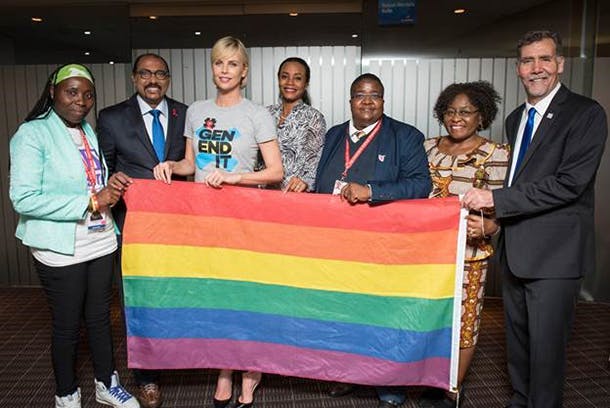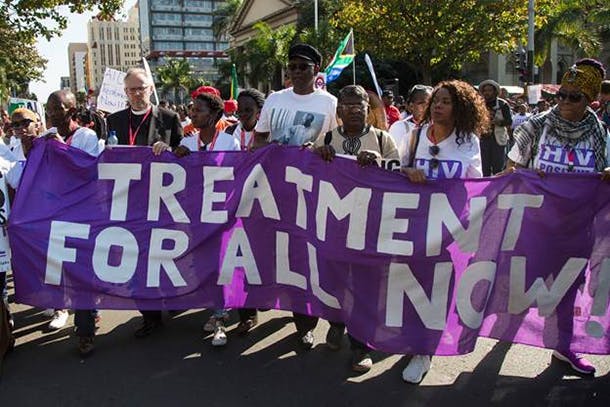
“The real reason we haven’t beaten the epidemic boils down to one simple fact: We value some lives more than others. …I know this because AIDS does not discriminate on its own. It has no biological preference for black bodies, for women’s bodies, for gay bodies, for youth or for the poor. It doesn’t single out the vulnerable, the oppressed, or the abused. …Yes, we have to all play our parts. We have to work harder, and faster, and smarter than ever before.” – Charlize Theron, United Nations Messenger of Peace
Last week at the 21st International AIDS Conference (AIDS 2016), more than 18,000 delegates from 183 countries gathered to present groundbreaking research, foster new partnerships, and celebrate the incredible strides made over the last few years to prevent and treat HIV/AIDS.
Throughout the conference, a clear message emerged: Funding is decreasing, momentum is stalling, and the world cannot afford to stop now if we truly want to end the HIV/AIDS epidemic.
Here are four key takeaways from AIDS 2016 to keep in mind as we work to end the epidemic of HIV/AIDS.
Progress is stalling, and funding is decreasing.
Thanks to programs like the Global Fund to Fight HIV, Tuberculosis and Malaria and the U.S. President’s Emergency Plan for AIDS Relief (PEPFAR); UN guidance and coordination; country leadership; and countless civil society advocates, there are 17 million people around the world on antiretroviral (ARV) treatment for HIV.
But there are still about 20 million HIV-positive people with no access to treatment, many of whom are the poorest and most vulnerable. At the same time, just when more funding is needed, the UNAIDS’ Prevention Gap report identified the first drop in HIV funding in five years – 13 of the 14 donor governments have cut their funding in the past year.
That is why on July 18, the civil society march took over the streets of Durban to demand treatment for all, to ask countries to fully fund the Global Fund during the Replenishment Conference in September, and to honor the rights of everyone, everywhere to live HIV-free.
We must reach the most vulnerable and at-risk populations.
HIV thrives on certain populations who often lack access to treatment and face harsh stigma and discrimination, including women and girls, sex workers and their clients, intravenous drug users, men who have sex with men, and transgender people. Even worse, many countries refuse to honor their rights and even criminalize homosexuality and punish sex workers, drug users, and people living with HIV.
On July 21, Sir Elton John reminded everyone that “no one can be left behind,” and without inclusion and respect for human rights, no amount of scientific progress can end AIDS. At the same time, Prince Harry urged us all to include and empower young people around the world to become the “new generation of leaders,” and that “without education and without empowerment, HIV will win.”

Ending AIDS: How do we get there?
Although we have many tools to fight HIV, there were still more than 2.1 million new infections reported in 2015 – two-thirds of which occurred in sub-Saharan Africa. UNAIDS has clear targets for 2020 called 90-90-90: 90% of all people living with HIV should know their status, 90% of all people with diagnosed HIV infection should receive sustained antiretroviral therapy, and 90% of people receiving the drug should have viral suppression.
That is why the South African government is moving to a “test and treat” approach in September to put anyone who is diagnosed with HIV on ARVs as soon as possible to preserve their immune systems. However, according to Anthony Fauci, Director of the National Institute of Allergy and Infectious Diseases, “The two greatest challenges remaining in HIV/AIDS research are finding a cure and developing a safe and effective preventive vaccine.”
Tuberculosis is the biggest killer of people living with HIV worldwide.
Tuberculosis (TB) is now the leading infectious disease killer, especially of people living with HIV. According to South African Minister of Health Dr. Aaron Motsoaledi, “TB and HIV are partners in crime. We will not end AIDS without ending TB.” Even scarier is that TB is air-borne and can spread quickly in close confines and across borders. Last year, TB sickened almost 10 million people and claimed 1.5 million lives, despite being preventable, treatable and curable.
To learn more about AIDS 2016, visit aids2016.org.
[Top photo: International AIDS Society/Steve Forrest/Workers’ Photos]
[Bottom photo: International AIDS Society/Rogan Ward]



 View All Blog Posts
View All Blog Posts